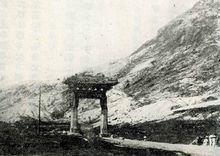Hangul 영은문 Revised Romanization Yeongeunmun | Hanja 迎恩門 McCune–Reischauer Yŏngŭnmun | |
 | ||
Similar Independence Gate, Seodaemun Independence Park, Dongnimmun Station, Seodaemun Prison, Samjeondo Monument | ||
The Yeongeunmun (literally "welcoming gate for obligation") was a historical gate located in present Hyeonjeo-dong, Seodaemun-gu, in the northwestern part of Seoul, South Korea. It was built in front of Mohwagwan (hangul: 모화관, hanja: 慕華館) during the Joseon Dynasty where envoys dispatched from Ming and Qing China were received as diplomatic guests.
Contents
In 1896, the gate was demolished along with Mohwagwan one year after the First Sino-Japanese War ended, which was a war between China and Japan primarily for the control over Korea. The Korean independence activist Seo Jae-pil (known as Philip Jaisohn) built the Independence Gate on the site with the desire towards inspiring the spirit of independence in Korea.
History
The Yeongeunmun Gate was located just outside the Donuimun (돈의문, 敦義門, West Gate) of the walled capital city of Hanseong (present-day Seoul). It was situated on the road from Seoul to Beijing, adjacent to the Mohwagwan. Its nearest post station was the Hongjewon (홍제원, 弘濟院).
Embassies were occasionally sent to Joseon by the emperor of the Ming Dynasty to announce imperial succession, investiture of a crown prince and others. When they reached the Hongjewon, they took off their traveling clothes and changed into formal attire. The next day, they received a reception from the king himself in front of the gate. The rite was performed by the king two times in the history of Joseon. After Ming China envoys move off to the gate, King Jungjong performed a rite, in the direction of the Ming Dynasty emperor. This ritual ceased in 1634.
The Mohwagwan was first built in 1407 as "Mohwaru" (모화루, 慕華樓) and then renovated in 1430. It was located adjacent to the Mohwagwan, a gate with rosewood pillars was built on the road.
In 1537 the gate was rebuilt in accordance with Ming Dynasty customs. Being roofed with blue tiles and had "Yeongjomun" (literally gate of welcoming imperial decrees) written on the front tables. In 1539 it was renamed to "Yeongeunmun" because the name of "Yeongjomun" was accused by the Ming Dynasty ambassador Xue Tingchong (薛廷寵). He claimed that since the imperial envoys carried imperial orders (勅), imperial decrees (詔), and imperial gifts, it was inappropriate to mention only imperial decree. The tablet was written by Zhu Zhifan (朱之蕃), who came to Joseon as an ambassador in 1606.
As a result of the Treaty of Shimonoseki (1895) which ended First Sino-Japanese War, Qing China recognized the "full and complete independence and autonomy" of Joseon Korea. In the next year Yeongeunmun was demolished leaving only its two stone pillars. In front of the remnant, the Independence Gate was built by Philip Jaisohn.
Location
Seodaemun Independence Park, including the remnants of Yeongeunmun, is easily accessed from exits 4 or 5 of the Dongnimmun Station on Seoul Subway Line 3.
